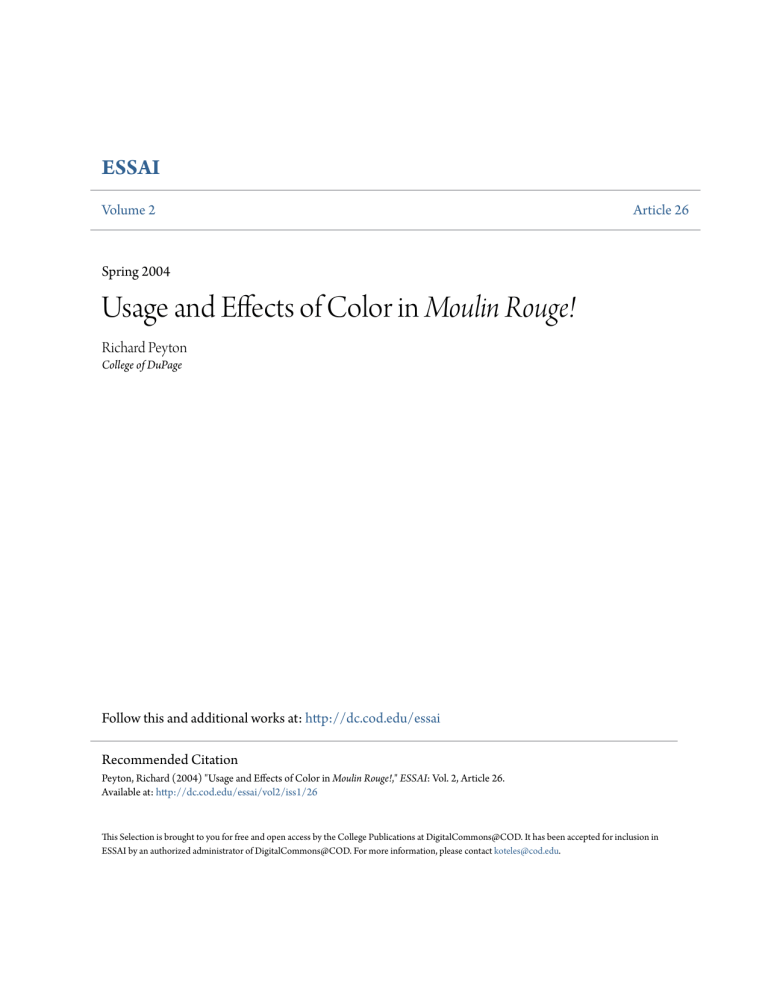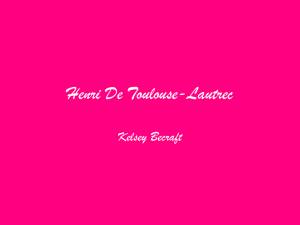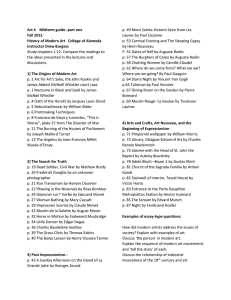Usage and Effects of Color in Moulin Rouge!

ESSAI
Volume 2
Spring 2004
Usage and Effects of Color in Moulin Rouge!
Richard Peyton
College of DuPage
Article 26
Follow this and additional works at: http://dc.cod.edu/essai
Recommended Citation
Peyton, Richard (2004) "Usage and Effects of Color in Moulin Rouge!
," ESSAI : Vol. 2, Article 26.
Available at: http://dc.cod.edu/essai/vol2/iss1/26
This Selection is brought to you for free and open access by the College Publications at DigitalCommons@COD. It has been accepted for inclusion in
ESSAI by an authorized administrator of DigitalCommons@COD. For more information, please contact koteles@cod.edu
.
Peyton: Usage and Effects of Color in <em>Moulin Rouge!</em>
Usage and Effects of Color in Moulin Rouge !
by Richard Payton
(English 135)
The Assignment: Students were asked to choose one film from a list of twelve, and to write an essay which explained how its director used color to enhance the story.
T he artistic continuum on which Moulin Rouge! belongs is, I think, quite clear, and I’m fairly certain that Luhrmann knows it. A trajectory is not hard to trace: in overall feeling, Verdi’s quintessential opera-melodrama La Traviata (or “Love in the Time of Tuberculosis,” as I like to call it, with its subtle parallels to the contemporary Garcia-Marquez classic); the visceral, riotous, licentious, primal, joyous Carmina Burana (both the 13 th century Latin and Middle High German texts and Carl Orff’s modern-day setting), among others. Visually, Luhrmann draws heavily on such works as
Van Gogh’s “The Night Café” and, appropriately enough, Toulouse-Lautrec’s “At the Moulin Rouge,” taking their slightly off-kilter perspectives and lurid (albeit muted) reds, greens, blues, and yellows, and infusing them with a high-intensity super-kinetic energy instantly recognizable to a generation raised on
MTV, imported British acid-house and Ecstasy-driven trance-rave culture.
One would think that a color analysis of such a vibrant movie would be a cakewalk – a taking of the candy from the proverbial baby, as it were. However, the viewer must still take care to avoid visual red herrings (or yellow, green, or blue herrings, as the case may be). This film may be the flashiest thing since the 1938 Technicolor Adventures of Robin Hood , but Luhrmann’s selection is as careful as any, such that, with a close dissection, the innumerable threads of color may be thinned down to a workable, meaningful amount. With this in mind, I have chosen to analyze Luhrmann’s storytelling techniques through the use of the following: the colors red and blue. Tracing these throughout the film, I will consider the nature of the colors’ presentation, the use of color in the setting of the mood, and possible symbolic interpretations.
Red is by far the most dominant color throughout, serving a variety of purposes and representing a variety of things. Two reds show up the most: we see the first, a considerably darker, almost maroon shade, at the very beginning of the film, in the curtain behind the conductor. The second, a higher intensity, is seen in the set and costumes of the Moulin Rouge itself. We can note also that a good half of the title is red – “rouge.” Is this a clue hinting that we should watch for the color? Or does the use of red merely establish the setting? Or is this use, perhaps, just a “rouge” herring? I’m inclined to think that it’s the first, and that we should pay extra careful attention to red in the film.
It’s a loaded color, if ever there was one. The amount of associations it carries is mind-boggling.
For this picture, there’s a strong link to “red light” districts, “scarlet women,” and the fact that in certain countries it is the custom for prostitutes to display red lights outside of their houses. There are biblical associations along these lines, as well: in the fortress city of Jericho, the harlot Rahab was to give a signal by hanging a scarlet rope out of her window – evidently a common symbol for harlots of the time. In this context, red brings with it associations of sin, corruption, extravagance, worldliness, and vice. After all, how is Satan most commonly depicted but as a red creature? Thus it is with the uses of red, among other things, that Luhrmann subtlety underscores the atmosphere of decadence apparent within the setting.
However, vice and decadence aside, what is Moulin Rouge!
but a love story? “… a bove all things a story about love” (my own emphasis), if the author is to be believed. The point is that red is, ironically enough, just as symbolic of love and passion as it is of vice and evil. A contradiction, yes, but is not the movie itself, in all its postmodern glory, just one gigantic, convoluted, multi-layered contradiction? The contrasts of meaning in red serve nicely to illustrate this point.
With its subconscious links to blood and fire, red represents life. The Moulin Rouge, with all its
Published by DigitalCommons@COD, 2004
93
1
ESSAI, Vol. 2 [2004], Art. 26 red trappings, is an establishment full of people living their lives with wild abandon; vivacious, hedonistic, energetic, non-stop. They are truly living for the moment. Similarly, Christian and Satine find greater fulfillment than they could ever have imagined in their love, and thus find themselves living more completely. In the words of the author, this is a story about “a love that will never die
.”
Contrariwise, with its subconscious links to blood and fire, red represents death. The Moulin
Rouge, with all its red trappings, is an establishment full of people on a frantic downward spiral into various unpleasant ends (untimely and painful death, suicide, alcohol and drug dependencies and venereal disease, etc) – we can draw parallels here with Poe’s story “The Masque of the Red Death,” in which a prince throws an extravagant party inside his sealed palace while outside his subjects die in a cholera epidemic. (We will return to the conflict between reality and illusion later. Right now, though, we stick to red and its associations with death). The red surrounding Satine is also a constant reminder that (as we know from Christian’s introductory comments) she is going to die of tuberculosis. A symptom of tuberculosis is the coughing up of blood. We see this happen and we can’t help but see her blood mirrored in the red surroundings, and, especially in the red carpet on which she finally dies.
Red also serves as a warning: stop signs are red, stop lights are red, the red lights on the Death
Star means it’s going to blow up. And, indeed, this notion of a warning can be applied in numerous ways to the movie, though two in particular stand out to me. First of all, the red cries out to us to stay away from Montmartre in general, and the Moulin Rouge in particular (“Turn away from this village of sin
!”).
Van Gogh said of “The Night Café” that it was a dangerous place for an artist such as he; a man “with no wife, no homeland, no real goal.” Whether Christian would have done well to heed this warning is a topic for debate – after all, where would the story be without, well, everything that happens? Secondly, the red again reminds us that this love between Christian and Satine is doomed to end tragically, as her condition slowly degenerates towards death, symbolic of the Moulin Rouge itself and the life-styles it propagates, and, more universally, of the powerful forces of chaos and entropy that surround us.
Finally, if we wanted to put a socio-political reading on this film, we could make remarks on red tape – for use in a neo-Marxist reading (the rest would write itself – talk about rampant consumerism, sheesh!) – and on red as a symbol both for communism and anarchy. This topic is, however, I think, subject matter for a different paper.
Where the two most common reds are shades, the two most common blues are both tints – not overly light, but still considerably lighter than a pure blue. The first we see at the very beginning, with
Christian sitting at his type-writer. This is the darker of the two, a somewhat unreal color, almost subterranean. The second shade is seen initially with the appearance of Satine – she descends in a mist of it and this is a colder, whiter tint. Very ice-and-snow-like.
With the overwhelming predominance of red, all other minor colors necessarily contrast with it, almost as if red were the background of a painting. Of all of these contrasts – and there are many – the contrast with blue, and these blues in particular, are the most striking. Where red is warm (or hot), lively and exuberant, demanding our attention, the blue is cold, sterile, understated, almost inhuman.
This is an exceedingly multi-layered, intertwining ouroboros-complex of a film, and I would argue that one aspect of the blue glow surrounding Christian at the beginning of the film is a device used by Luhrmann to signal a transition to a different plane of narrative reality. We descend, from our vantage points as viewers, into a movie of a play about a man writing a story, via shots of him writing the story, into the story itself. Blue is often associated with sleep, dreams, and hallucinations. It has already been noted that this particular blue has an unreal feeling to it, suggesting that perhaps the story which we are about to witness is not completely free of the hazy obscurity of memory and impression, or of the influence of dream, hallucination, idealization, and (as we actually see), of absinthe. In the end, we move again through a transitional blue and into a scene more realistically colored, which, we assume, is the end of the play (and which is certainly
the end of the movie).
Interconnected, and equally as convoluted as the picture itself, are the associations of blue with not only dreams and sleep, but also with water, the ocean, and, thus, the subconscious. These psychological associations suggest that the film will go much deeper than at first meets the eye.
The contrast of blues and reds, seems to me to be symbolic of reality verses unreality. For http://dc.cod.edu/essai/vol2/iss1/26
94
2
Peyton: Usage and Effects of Color in <em>Moulin Rouge!</em> example, at the end of Christian’s story, we rise through the ceiling of the Moulin Rouge and into the outof-doors, which has been covered with a blue snow. Red interior, blue exterior. As Zidler remarks at one point, “outside it may be raining/ but in here it’s entertaining.” The Moulin Rouge is a place where one goes to escape
reality – the blue
reality, let us note – of rain, which we can interpret as the worries and troubles of life. The Moulin Rouge makes a profit off of escapism, which provides us with yet another layer of self-reference – after all, isn’t that where most movies turn their profit?
It’s also interesting to note the juxtaposition of red and blue in the relationship between Christian and Satine: as I’ve already mentioned, red can symbolize many things, but it takes on a whole new meaning when viewed within the context of reality (blue) verses unreality (red). Their relationship is so immersed in red, suggesting that the happiness we see cannot be realistic – after all, it’s just going to end tragically, as we know. The reality
is that Satine is going to die of tuberculosis, something foreshadowed early on – by the dialogue, but, more subtly, by Satine’s first appearance on screen, hovering above her audience like a spirit, ghostly in a mist of shimmering, cold, blue
.
Works Cited
Moulin Rouge!
Dir. Baz Luhrmann. Perf. Nicole Kidman, Ewan McGregor, John Leguizamo, and Jim
Broadbent. 2001. DVD. 20th Century Fox Home Entertaiment, 2002.
Published by DigitalCommons@COD, 2004
95
3





